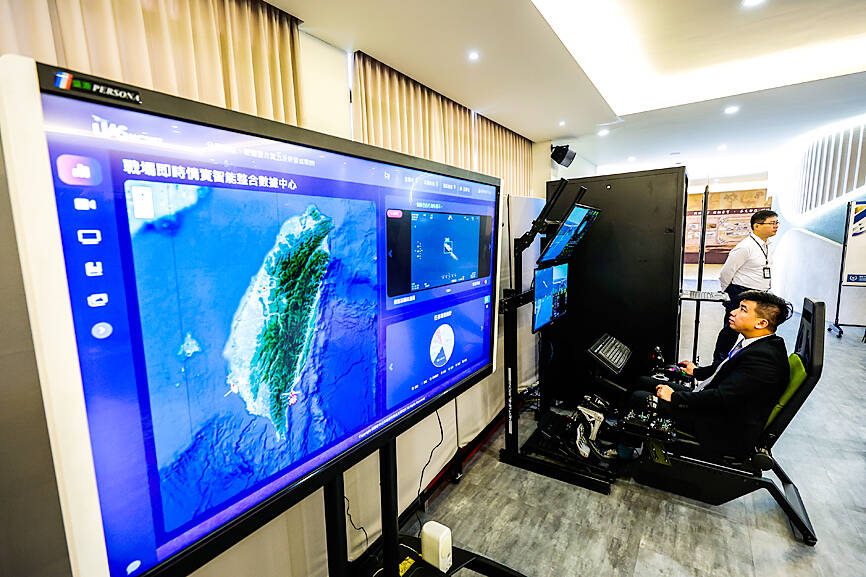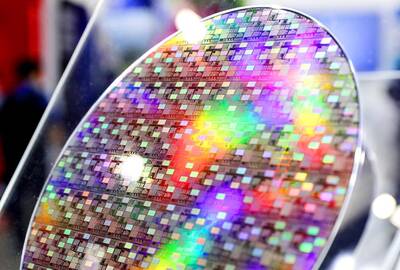The Chungshan Institute of Science and Technology received an order from the navy for a domestically developed exploding drone, the state-owned defense technology research group said yesterday.
The institute is conducting the final certification tests before delivering Loitering Munition 1 to the navy, institute aeronautics systems research division director Yeh Chia-fan (葉嘉範) told a news conference unveiling training simulators in Taichung.
The institute’s Teng Yun 2 (騰雲二型, “Cloud Rider”), Albatross II (銳鳶二型) and Cardinal (紅雀) uncrewed aerial vehicles have been presented to the armed forces after completing all tests, he said, adding that the drone systems are being fielded in batches as the budget permits.

Photo: Ritchie B. Tongo, EPA-EFE
Loitering Munition 1 features an electro-optical infrared camera system, a tablet-based controller and a launcher that uses compressed air, the institute said.
It utilizes a high-explosive warhead and can be deployed against personnel, vehicles and other high-value targets at a range of more than 100km, with a loitering time of 15 minutes, it added.
The institute is developing Loitering Munition 2, an optionally autonomous weapon that uses radar and infrared guidance, and has foldable wings, pods for installation in vehicles and ships, and a hybrid gas-diesel-electric power source.

Photo: Liu Hsin-de, Taipei Times
Speaking on condition of anonymity, a source said the performance of Loitering Munition 1 suggests that the system is intended for use by ground forces, meaning the navy is probably buying the weapons for the Marine Corps.
Loitering Munition 1’s procurement is likely listed in the classified portion of the defense budget, as the nonclassified part contains no reference to it, they said.
Separately, Yeh said the institute has completed eight types of training simulators, including a virtual reality-based system for training remote pilots to perform takeoffs, landings and other skills.
Another drone simulator — designed to train remote pilots and payload operators in advanced tasks — would feature realistic instrument panels, high-definition camera feeds and simulated links with the drone intelligence center, he said.

WAITING GAME: The US has so far only offered a ‘best rate tariff,’ which officials assume is about 15 percent, the same as Japan, a person familiar with the matter said Taiwan and the US have completed “technical consultations” regarding tariffs and a finalized rate is expected to be released soon, Executive Yuan spokeswoman Michelle Lee (李慧芝) told a news conference yesterday, as a 90-day pause on US President Donald Trump’s “reciprocal” tariffs is set to expire today. The two countries have reached a “certain degree of consensus” on issues such as tariffs, nontariff trade barriers, trade facilitation, supply chain resilience and economic security, Lee said. They also discussed opportunities for cooperation, investment and procurement, she said. A joint statement is still being negotiated and would be released once the US government has made

NEW GEAR: On top of the new Tien Kung IV air defense missiles, the military is expected to place orders for a new combat vehicle next year for delivery in 2028 Mass production of Tien Kung IV (Sky Bow IV) missiles is expected to start next year, with plans to order 122 pods, the Ministry of National Defense’s (MND) latest list of regulated military material showed. The document said that the armed forces would obtain 46 pods of the air defense missiles next year and 76 pods the year after that. The Tien Kung IV is designed to intercept cruise missiles and ballistic missiles to an altitude of 70km, compared with the 60km maximum altitude achieved by the Missile Segment Enhancement variant of PAC-3 systems. A defense source said yesterday that the number of

‘CRUDE’: The potential countermeasure is in response to South Africa renaming Taiwan’s representative offices and the insistence that it move out of Pretoria Taiwan is considering banning exports of semiconductors to South Africa after the latter unilaterally downgraded and changed the names of Taiwan’s two representative offices, the Ministry of Foreign Affairs (MOFA) said yesterday. On Monday last week, the South African Department of International Relations and Cooperation unilaterally released a statement saying that, as of April 1, the Taipei Liaison Offices in Pretoria and Cape Town had been renamed the “Taipei Commercial Office in Johannesburg” and the “Taipei Commercial Office in Cape Town.” Citing UN General Assembly Resolution 2758, it said that South Africa “recognizes the People’s Republic of China (PRC) as the sole

Taiwanese exports to the US are to be subject to a 20 percent tariff starting on Thursday next week, according to an executive order signed by US President Donald Trump yesterday. The 20 percent levy was the same as the tariffs imposed on Vietnam, Sri Lanka and Bangladesh by Trump. It was higher than the tariffs imposed on Japan, South Korea and the EU (15 percent), as well as those on the Philippines (19 percent). A Taiwan official with knowledge of the matter said it is a "phased" tariff rate, and negotiations would continue. "Once negotiations conclude, Taiwan will obtain a better